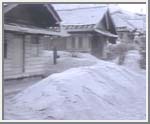|
COMETS EARTH JUPITER KUIPER BELT MARS MERCURY METEORITES NEPTUNE OORT CLOUD PLUTO SATURN SOLAR SYSTEM SPACE SUN URANUS VENUS ORDER PRINTS
PHOTO CATEGORIES SCIENCEVIEWS AMERICAN INDIAN AMPHIBIANS BIRDS BUGS FINE ART FOSSILS THE ISLANDS HISTORICAL PHOTOS MAMMALS OTHER PARKS PLANTS RELIGIOUS REPTILES SCIENCEVIEWS PRINTS
|
Related Document
Download Options
This video clip was taken from, "Understanding Volcanic Hazards", © 1995, International Association of Volcanology and Chemistry of Earth's Interior (IAVCEI). The following was taken from the video: When ash falls back to the ground it turns everything deathly gray. Falling ash can strip leaves and limbs from trees. If enough ash falls, fruit orchards and entire forests are left barren. A thick layer of ash can destroy crops and leave farm land unworkable for weeks or months at a time. Fields can be made useless for grazing animals and water may be unsuitable for drinking. Falling ash affects people farther from an erupting volcano than any other type of activity. For thousands of square kilometers roads and houses are blanked with ash. Water supplies, communication systems and power generators can be shut down completely. If enough ash fall on a house or building, the extra weight can form holes in the roof or cause it to collapse entirely injuring and sometimes killing people inside. Ash also makes driving difficult by creating a choking cloud that makes it impossible for drivers to see where they are going. Falling ash usually creates a very dense haze sometimes turning day into night and creating a darkness that light can't penetrate. Its an erie darkness and will last for as long as the ash falls. For some people, ash makes breathing strenuous and it irritates their eyes. |
